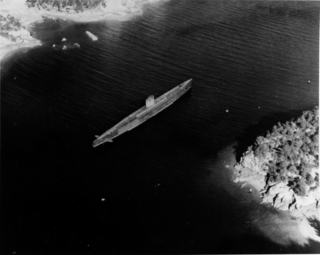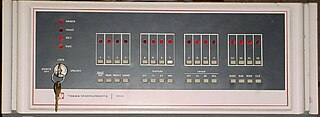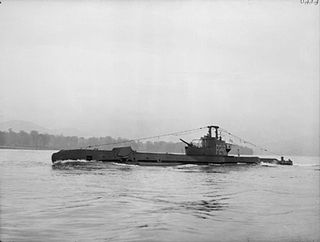
The I-201-class submarines were submarines of the Imperial Japanese Navy during World War II. These submarines were of advanced design, built for high underwater speed, and were known as Sentaka-Dai type submarine or Sentaka type submarine. The type name, was shortened to Suichū Kōsoku Sensuikan Ō-gata.
HMS Seraph was an S-class submarine built for the Royal Navy during the Second World War. Completed in 1942, she carried out multiple intelligence and special operations activities during World War II, the most notable of which was Operation Mincemeat.
The IBM 728 magnetic tape drive was used on the SAGE AN/FSQ-7 computer. It was physically similar to the IBM 727, but with significantly different specifications.

HMS Artful (P456), was an Amphion-class submarine of the Royal Navy, built by Scotts Shipbuilding and Engineering Company of Greenock and launched 22 May 1944.

The TI-990 was a series of 16-bit minicomputers sold by Texas Instruments (TI) in the 1970s and 1980s. The TI-990 was a replacement for TI's earlier minicomputer systems, the TI-960 and the TI-980. It had several unique features, and was easier to program than its predecessors.
HMS R1 was one of 10 R-class submarine built for the Royal Navy during the First World War. The boat was completed shortly before the end of the war and was sold for scrap in 1923.

The Rainbow-class submarine or R class was a quartet of patrol submarines built for the Royal Navy in the early 1930s.

HMS R3 was one of 10 R-class submarine built for the Royal Navy during the First World War. The boat was not completed before the end of the war and was sold for scrap in 1923.
HMS R4 was one of 10 R-class submarine built for the Royal Navy during the First World War. The boat was not completed before the end of the war and was sold for scrap in 1934.
HMS R9 was one of 10 R-class submarine built for the Royal Navy during the First World War. The boat was not completed before the end of the war and was sold for scrap in 1923.
HMS R10 was one of 10 R-class submarine built for the Royal Navy during the First World War. The boat was not completed before the end of the war and was sold for scrap in 1929.
HMS R11 was one of 10 R-class submarine built for the Royal Navy during the First World War. The boat was not completed before the end of the war and was sold for scrap in 1923.
HMS R12 was one of 10 R-class submarines built for the Royal Navy during the First World War. The boat was not completed before the end of the war and was sold for scrap in 1923.

HMS Satyr was an S-class submarine of the Royal Navy, and part of the third group built of that class. She was built by Scotts, of Greenock and launched on 28 September 1942.

HMS Scotsman was a third-batch S-class submarine of the third batch built for the Royal Navy during World War II. After training exercises in Britain during which she ran aground, requiring repairs, she was transferred to the Pacific fleet as the war with Germany had ended. The submarine sank one junk en route to her submarine unit, but arrived after the end of the Pacific war and World War II. She was scrapped in November 1964.

The United States D-class submarines were a trio of submarines built for the United States Navy in the first decade of the 20th century. All three ships served during World War I providing training for crews and officers on the US East Coast, before the class was decommissioned and sold for scrap in 1922.

HMS Unrivalled (P45) was a U-class submarine built for the Royal Navy during World War II. The boat has been the only ship of the Royal Navy to ever bear the name Unrivalled. Completed in 1942, the boat spent most of the war in the Mediterranean. She sank a number of small merchant ships and naval auxiliaries, but major success eluded her during the war. Too small and slow for the post-war environment, Unrivalled was scrapped in 1946.

The R-class or Romolo-class submarine was a group of submarines built for the Royal Italian Navy during World War II. They were designed as blockade running transport submarines for transporting high-value cargo from Europe to Japan and vice versa. Axis-occupied Europe lacked strategic materials such as tungsten, tin and some commodities such as rubber.
In mathematics, the hyperoperation sequence is an infinite sequence of arithmetic operations (called hyperoperations in this context) that starts with a unary operation (the successor function with n = 0). The sequence continues with the binary operations of addition (n = 1), multiplication (n = 2), and exponentiation (n = 3).















